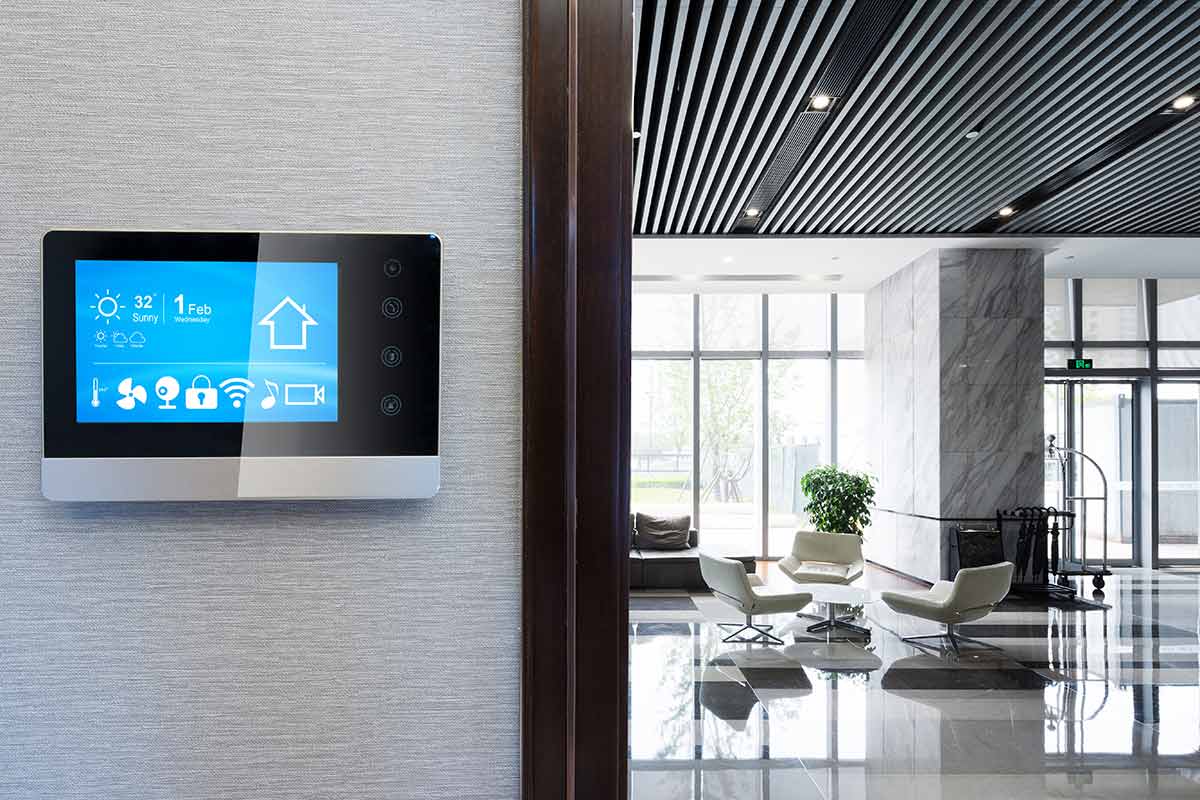Smart Building Technology: How LON And ANSI/CTA 709.8 Enable Building Automation Networks

The global smart building market is expected to reach $108.9 billion by 2025.
This impressive growth has boosted the demand for smart building and building automation networking solutions.
One of these solutions is the high-speed LON HD-PLC network, promoted by Lonmark and made possible by the ANSI/CTA 709.8 standard.
In this blog post, we will provide a detailed overview of this technology, including:
- The basic principles of the LON technology
- How the ANSI/CTA 709.8 standard helps combine the benefits of HD-PLC and LON
- The uses cases of LON HD-PLC technology in smart and automated buildings
Smart Building: What Is It?
A smart building is a colloquial term for a building that is equipped with automation technology — a communication framework that helps automate the building’s operations.
The communication framework of a smart building usually consists of a wide array of interconnected devices, such as sensors and cameras, that monitor specific building conditions and characteristics.
The data gathered from these devices is then processed by a centralized software, commonly known as a Building Management System (BMS).
By analyzing this data, the System can alter the smart building’s operations in real-time to reach the desired condition.
Some of the building systems that can be automated and controlled by a smart building framework include:
- HVAC systems
- Power supply
- CCTV and security
- Fire safety systems
- Lighting
For example, an automation system can control the ventilation of the building and adjust the supply of outside air flowing in, by analyzing the temperature and CO2 levels of the air inside.
The degree of automation can vary in a given building and, theoretically, it can go as far as a building that is completely autonomous and doesn’t require human input to function.
What Is LON Technology?
Also known as LonWorks, LON stands for Local Operating Network and is a networking platform designed specifically for control and automation systems — such as those found in smart buildings.
LON is certified by the ISO/IEC 14908-1 and ANSI/CTA 709.1 standard together with the associated specifications.
This protocol, which outlines the peer-to-peer and master-slave communication within a network, enables the key elements of a LonWorks network — nodes — to communicate with each other.
In a LON-enabled building automation infrastructure, each node is an individual device — such as a sensor in a piece of factory equipment, for instance. These devices are organized and interconnected on two levels:
- A subnet that can include up to 127 nodes
- A domain that can include up to 255 subnets
As a result, one LON domain within a network can be comprised of as many as 32,385 nodes.
Moreover, several LON domains can be interconnected, enabling LON’s flexibility when it comes to network topology.
LonWorks can be implemented following a variety of conventional network structures, including:
- Bus topology: where each node is connected to a single cable
- Star topology: where nodes are connected to a central hub
- Ring topology: where the nodes are connected in a closed loop
- Tree topology: also known as the hybrid star-bus network, where sets of star networks are interconnected in a bus topology manner
The free choice of network topology that LON takes advantage of is largely due to another one of the technology’s key benefits — flexible support of cabling standards.
LON platforms can function over a variety of cables, including:
- Twisted pair cables
- Power supply lines
- Coaxial cables
- Optic fiber
This flexibility means that installing LON infrastructure in a building, factory or solar power plant does not require additional investment into cabling installation, as it can work with the existing cables.

What Is The ANSI/CTA 709.8 Standard And How Does It Help Combine The Benefits Of LON And HD-PLC?
ANSI/CTA 709.8 standard, issued in February 2020, outlines the integration of the HD-PLC protocol into LON systems.
Before the adoption of the standard, LON systems mostly relied on older, slower networking protocols, such as BPSK-PLC or RS485.
The main limitations of these standards have to do with the maximum supported number of nodes and data transmission rates.
Both BPSK-PLC and RS485, for instance, only support a maximum of around 200 nodes and a maximum physical layer transmission rate of around 5 and 9.6 Kbps, respectively.
By combining the domain capabilities of LON and the broadband connectivity of HD-PLC, the ANSI/CTA 709.8 standard enables the creation of networks that can include as many 1,024 nodes communicating at megabit speeds.
The support of 1,024 nodes in a LON HD-PLC system is made possible by one of HD-PLC’s unique features — Multi-hop technology.
HD-PLC Multi-hop uses the Centralized Metric-Based Source Routing (CMSR) protocol, which enables the use of terminals that effectively extend the network range — albeit at the cost of connection speed.
Other key features that the ANSI/CTA 709.8 standard outlines include:
- Wavelet OFDM: A modulation method that helps minimize data loss in a network, enabling higher data transmission rates.
- Carrier-Sense Multiple Access with Collision Avoidance (CSMA/CA): A network access method in which the nodes only communicate with each other when the network is free to avoid collisions that result in data loss.
- Advanced security protocols: AES 128-bit encryption, VLAN, SSL, Pairwise Key and so on.
- IPv4/IPv6 protocol support
Combined with the fact that HD-PLC can work with any kind of wiring, these technical features enable a large variety of smart building use cases for the ANSI/CTA 709.8-certified networks, such as:
- HVAC systems: A HVAC automation system can be constructed using the LON HD-PLC Multi-hop solution over twisted pair wiring. By using a single HD-PLC bridge that all the components of the HVAC network are connected to instead of costly individual gateways, the overall cost of the network can be reduced significantly — while maintaining megabit connection speeds.
- Automated lighting: Automated lighting can be connected with the HD-PLC protocol over the existing DC power lines, eliminating the need for installing additional wiring.
- Wi-Fi connectivity in hard-to-reach places: LON HD-PLC can be used to extend the Wi-Fi connectivity in hard-to-reach places, such as tunnels or basements, via the PLC/Wi-Fi bridge and terminals that act as network repeaters. Just like other use cases, this solution does not require significant investment as the Internet connection can be transferred via the existing powerlines.

What To Consider When Building A LON HD-PLC Network For Building Automation Functionality
LON HD-PLC is a relatively straightforward, cost-effective solution that can be a great option in smart building use cases.
Nevertheless, there are still two things to consider when building a LON HD-PLC network: network planning and network design.
Consideration #1: Network Planning
Smart building network planning has to do with one key characteristic of any network — range.
One of the factors that affect the network range the most is known as the link budget.
The link budget is a measurement of signal strength loss between the transmitter and the receiver in a given network — a phenomenon known as signal attenuation or degradation.
Signal attenuation usually occurs due to the following factors:
- Cable loss that increases together with the length of the cabling
- Branch loss that occurs at points where the main cable connection branches out into secondary channels
- Signal reflection that happens whenever there is a mismatch in the signal impedance, disturbing the original signal
- Multipath fading where the signal travels from the transmitter to the receiver via several paths, deteriorating the original signal
Signal attenuation is measured in decibels. In the case of ANSI/CTA 709.8, the maximum acceptable signal attenuation — also known as the dynamic range — is 85 dB.
By subtracting the branch loss from the dynamic range and dividing the result by the cable loss, it is possible to estimate the maximum possible network range.
Other key factors that contribute to the overall link budget of a network include:
- Tx power — the strength of the transmission signal
- Signal-to-interference-plus-noise ratio (SINR) — the total transmission strength of a signal divided by its total loss and interference
- Noise — background electromagnetic interference that depends on the environment
Consideration #2: Network Design
Network design has to do with the physical layout of the communication infrastructure — its topology, in other words.
As mentioned above, LON HD-PLC supports free topology, meaning it can be implemented following any existing outline.
While the free choice of topology is convenient when building a network, optimizing the performance of such a network can be challenging — especially in a large-scale installation.
Fortunately, one of ANSI/CTA 709.8 main advantages is its support of network extension using other communication mediums, such as Ethernet and Wi-Fi.
For example, a large smart building network that has more than two transformers — such as one in a skyscraper, for instance — would suffer from considerable signal attenuation.
One way to solve this challenge would be to bypass the signal transfer via an L2 switch or a sub-network of interconnected Wi-Fi bridges.
Smart Building Powered By LON HD-PLC: Recap
Building automation is a rapidly growing industry that requires reliable, cost-effective networking solutions.
For a long time, LonWorks (or simply LON) was dominating the building automation market.
However, this technology was constrained by several technical limitations — such as limited range and data transmission rate.
The ANSI/CTA 709.8 Standard that outlines the implementation of the HD-PLC protocol in LON helped alleviate these limitations, bridging the gap between narrowband power line communication and costly Ethernet and Wireless communication solutions.
The unique features of LON HD-PLC — such as its flexibility, ease and low cost of installation — are enabling the technology to set a new standard in the building automation industry.




